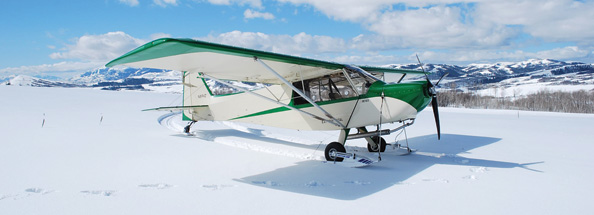
Since the summer of 2009, I had been flying with Alaskan Bushwheel’s 26-inch Airstreaks on my RANS S-7S. Here in my corner of Idaho, vast areas of terrain for off-airport landings have opened up, so much so that once the deep snows of winter arrived I found it frustrating that even with the Airstreaks I was now confined to flying from plowed airstrip to plowed airstrip. This simply wouldn’t do! I clearly remember the moment when the idea of skis popped into my mind: I was flying over a remote valley, and it was absolutely, perfectly smooth with a recent snowfall, yet all I could do was look at it. I wanted the same freedom in the winter that I had in the summer, and once back home, I started to get educated on the options.
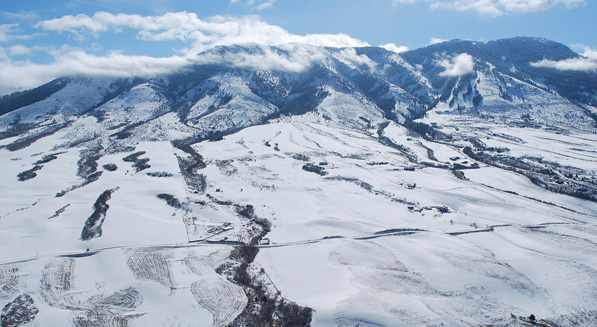
Home sweet home, the Portnuef Range of southeast Idaho. Bonneville Peak, at 9271 feet, is the highest, and a great ridge-soaring site. The author had a deadstick 2+ hour soaring flight there this year in the S-7S. (He’s a former hang-glider pilot).
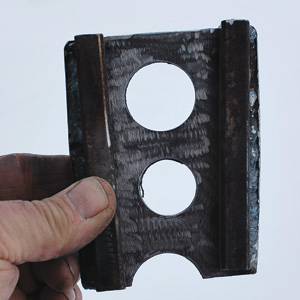
Part of the tailwheel ski attach bracket; this part sandwiches the Matco tail fork in such a way as to be mechanically secure without drilling any holes in it.
Why the Wheels?
I needed wheel skis, because with the elevation changes in my area (4000 to 10,000 feet ASL), many times the valleys are bare of snow, but high up there is plenty. Plus, I have a gravel driveway and a concrete hangar floor and did not want to mess with a dolly. A Canadian company, Datum, Inc., popped to the forefront, its web site showing some excellent videos of ski flying in the Alps after taking off from a paved airstrip. The skis were built for Light Sport-type aircraft, and had plenty of surface area for deep powder, while retaining full hard-surface capability when on the wheels. Grass and dirt runways would also be available when using the wheels. These skis seemed to have the best all-around capability I was looking for. I would have to give up the Airstreaks for the winter, however; 6.00 is the largest tire I could use with the skis. I rotate the Airstreaks every season anyway, which involves taking them off the wheels rather than a simple side-to-side swap, so now I just perform this chore when changing over from the ski tires.
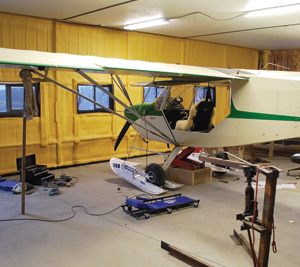
Jacking the plane up so that the ski angles could be rigged took some doing. It was more difficult than simply lifting one wheel at a time to change a tire.
With Bated Breath
Decision made, and money sent, I was now in a big hurry to get them, as the winter was quickly coming to an end, at least “down lower.” Datum is based in Montreal, and I expected a bit of a hassle dealing with the international border. It went smoothly, but seemed to take forever until I came home one day and saw that UPS had been by. Before even opening the boxes I had a warm, fuzzy feeling. After a few weeks of buyer’s remorse, and then waiting what seemed an interminable period (actually 30 days or so), I was really glad to see the shipment had arrived unscathed; the extremely well-packed boxes were a good indication that I was getting a quality product. After admiring the boxes for a minute, I tore into them and for the first time saw my new skis. They were much smaller then I thought they’d be…oh, wait a minute, that’s the tail ski! Wow, nice quality and everything top notch. My buyer’s remorse was quickly put to rest.
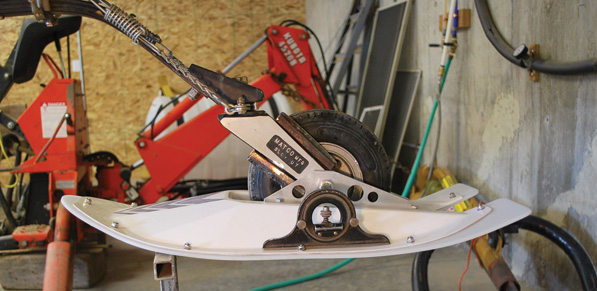
Setting the angle of the tailwheel ski bracket. A bubble protractor came in handy here.
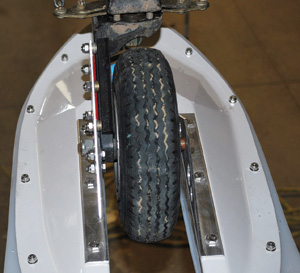
The finished (author’s design) tail ski attach bracket, for a Matco 8-inch tailwheel. Full tailwheel function is retained.
Installation Station
The first order of business was to machine my existing solid 1.5-inch axles for the new axle inserts. A local machine shop did this free of charge; I just had to take the owner flying. No problem there! The axle inserts really don’t take the landing loads; they just serve to position the skis. As far as the landing gear knows, all load paths are the same. The brake calipers were repositioned, which was a simple matter of drilling new holes in the backing plate so that they would not interfere with the ski structure during extension or retraction. Later, after hoisting the plane with a belly jack so that the tail and maingear were both off the hangar floor, and using an adjustable bubble protractor and Datum’s instructions, it was easy to rig the supplied cables to the proper lengths.
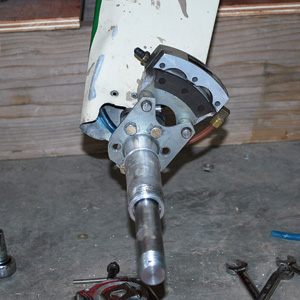
The brake caliper used to be positioned below the axle centerline, where it interfered with the ski. It was a simple job to reposition it up higher and out of the way. George Happ at Matco helped out here.
Allowing the skis the necessary freedom of movement while limiting their movement at the proper extremes is a simple matter of swedging the supplied aircraft cable at the correct lengths. Finding hardpoints on the S-7S’s airframe was dumb luck. In the rear, some prewelded bushings (for float installation, I guess) were in just the right place, so a couple of old hang-glider stainless cable tangs were bolted into place and the cables rigged to them. Installing a longer bolt and two more tangs at the lift strut fuselage fitting took care of the forward cables. The front bungee and crust cutter cable needed the most forward attach point. A little time spent under the panel showed an existing firewall airframe gusset, drilled and equipped with an aluminum bushing to serve as a standoff, that would do the job. The standoff is used so the bungee hook and cable tang don’t scratch the boot cowl.
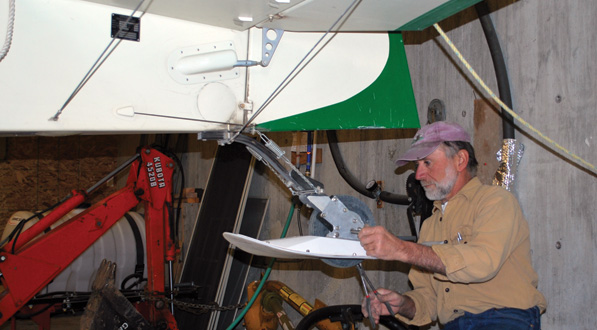
Simko reinstalls the tailwheel ski.
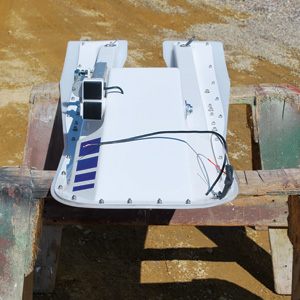
First look. The author had just taken them out of the very well-built shipping boxes. Note: The sawhorse legs are from a 1946 Taylorcraft wingspar that was salvaged.
The last order of business was electrical. The Datum skis are moved fore and aft by 12-volt linear actuators of industrial quality. As they are moved, strong springs and a trick linkage make the tires ride up on top of the skis, where they are faired in by the forward ski structure. This results in all landing loads being applied to the airframe in the usual fashion: through the tires. It also means little if any extra drag, as the faired-in tires make up for the ski drag. When reversed, the skis move up in such a way that the tires are the first thing to touch down as they protrude through the split ski tails. Though it’s hard to explain, it’s simple in operation.
A new 10-amp breaker and a new hole on each side of the boot cowl for each ski’s cable harness (actually just two conductor cables with a wear-proof outer sheathing) get the needed power from the panel to the skis. A two-position switch (SKIS/WHEELS, hard to get that confused) is used as needed to position the skis. This system is powerful enough to operate in the air and on the ground or snow with the airplane occupied—an important feature. Rubber grommets cleaned up the boot-cowl hole, and cable quick disconnects for easy seasonal change-outs along with little rubber corks to plug the holes when the cables are removed make the entire installation minimally invasive. In other words, it doesn’t look bad. Quick links on the other rigging cables serve to disconnect the stainless tangs, which stay on the airframe because they are too small and light to worry about, especially on a 100-mph or so airplane. Reinstallation each season should take less time than doing the tire swap: 30 to 45 minutes.
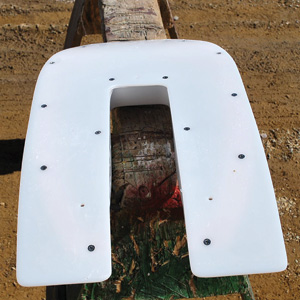
Bottom view of one of the main skis. Simko likes the way the ski distributes the weight, and it also has plenty of surface area for good flotation in fresh snow.
The wheel penetration tail ski, a cute little thing, was secured to the 8-inch Matco tailwheel—clamped, in effect, so that the tailwheel assembly retains its full range of motion and is not weakened by any drilled holes. With the plane still off the hangar floor, the skis were double-checked for the proper angle of attack, both while retracted and extended. After the airplane was let down off the jacks, I was able to actuate the system for the first time while sitting in the cockpit. Everything worked as it should, so it was time to go flying. I had previously determined that the center of gravity had stayed within bounds, and the total ski installation added about 55 pounds; this was after substituting the lighter 6.00 tires for the 26-pound Airstreaks.
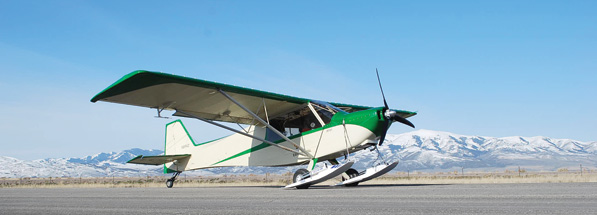
One of the rare times the plane was on asphalt; the skis are well clear, and wheeled ops are normal. The author misses his big fat 26-inch Airstreaks, though.
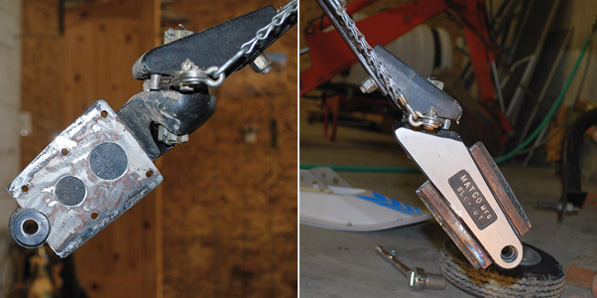
Two views that show more of the tail ski attach bracket.
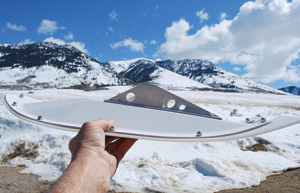
The tail ski, such a cute little thing!
And We’re Off!
My first takeoff would be on the wheels, on my snow-packed, 12% grade, 400-foot-long strip. While the ride on the little 6.00 tires was, as expected, a little rougher than I was used to with the cushy Airstreaks, the takeoff was routine. After lift off, I hit the switch to SKI mode, as that is the preferred in-flight position, and it was a thrill to see the wheels ride up onto the skis just as they should, with cycle times of about 20 seconds. As I flew the few miles to my first flatland ski landing, I slowly increased the airspeed to my usual cruising speed of 90 mph or so, while keeping a close eye on the skis’ angle of attack. Everything stayed the same, indicating they were “flying” just right, at a neutral or slightly positive AOA. Plus, the cable harness (secured to the bungees in such a way as to not constrain their movement, but also to not flop in the breeze) and the bungees were stable in flight, no flopping around, nice and stable.
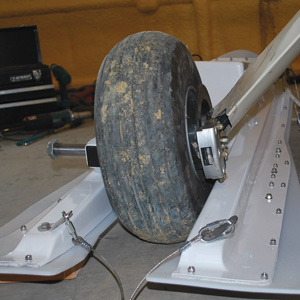
This photo shows that the brake caliper would have interfered with the ski before it was moved.
All the snow was gone in the valley (1000 feet below my place), but a small amount was left at a residential airpark 10 miles away, and as I set down for what was to be my last level ground landing for a while, it appeared I had plenty of room. Between the slightly higher airspeed at touchdown (I wheel landed instead of my usual three point), I quickly realized the short stretch of snow I was landing on was not long enough. This presented no problem, however, as by the time I ran off the snow pack and onto the frozen grass, I was going only 10 mph. These skis are slick, and the grass, while not as slippery as the snow, was nowhere near grabby enough to be a problem. My first ski landing! But now what? Simple. I went to WHEEL mode, stomped on a brake and kicked the tail around in the usual fashion, taxied up to the snowpack, went back to SKI mode and took off. Already I really liked the versatility of these skis!
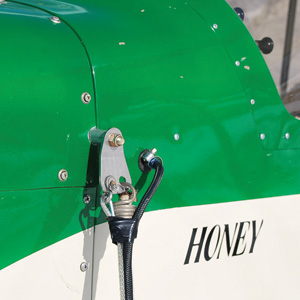
The stainless attach tang (included with the skis, as was almost all required hardware) and the standoff that gets it a little bit away from the boot cowl so it doesn’t get scratched by the bungee hook.
My arrival back home meant my first uphill landing on skis. Taking care to land as short as possible, and three point this time, I had plenty of room and had to add throttle to continue the taxi uphill to the gravel driveway leading to my hangar. Holding enough throttle to maintain position (I have a rearview mirror in the tandem cockpit, but it’s for keeping an eye on my passengers, not to see while taxiing backward), I lifted the skis up and smartly taxied up onto the gravel, with nary a scratch in the ski bottoms. Pulling the plane backward into the paved hanger was routine.
Let’s Do That Again
A post-flight inspection showed nothing amiss, so the next day I took off and made a couple dozen landings and takeoffs on the nearby hillsides, all of them steep enough that I didn’t dare shut down the engine before turning sideways. It’s true that the skis have skegs on the bottom to provide some sideways traction, but on the steeper grades—some of them near 20%—I could not park. I could land but then immediately, while keeping a little speed up, I had to do a 180 and blast off again.
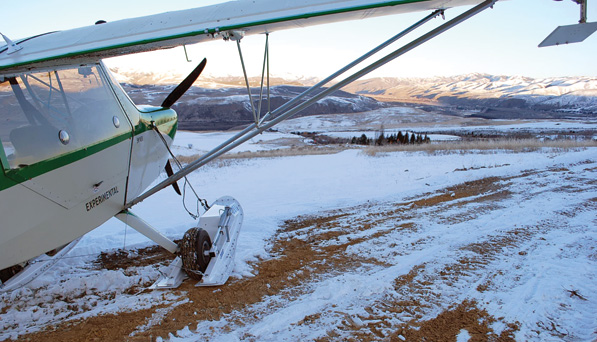
A good example of why Simko wanted wheel/skis, and not simple skis. He routinely has to deal with pavement, gravel and deep snow—all in the same flight.
I quickly learned that having the room to get turned around for takeoff was the most important aspect of an uphill landing. Having a double fall line (side-to-side slope in addition to the up-and-down slope) meant I had better land on the lower side and make my turn to the upper side; doing the opposite ate up a lot more room. Keeping some power on meant more rudder control, and being too timid and backing off the throttle could be worse than firewalling it in a tight area. (I figured all this out without denting or scratching anything.) I fly these hills all the time in the summer, and that helped a lot, as did the fact that I snowboard many times a week at the nearby ski area, which gives me more of a handle on the snow conditions. Mushy and grabby snow requires different techniques than hard, slick snow, and conditions can change as the day progresses. Knowing that a slope has been in the sun all day versus being in the shade can also help. The skis I have are rated for a 2000-pound-gross aircraft, so they offer plenty of flotation for the 1320-pound-gross S-7S.
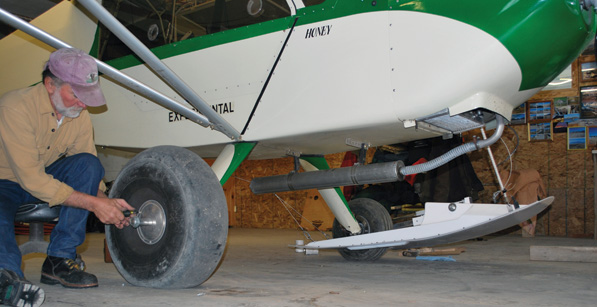
Off come the 26-pound Airstreaks in favor of the lighter 6.00 tires.
A couple of memorable flights stand out: a breakfast flight to Afton, Wyoming, less than an hour away, but over a lot of remote country. Knowing I could land anywhere was a thrill and a real safety feature. After landing and taking off on the plowed asphalt runway, I landed 20 or 30 times on the way home and, yes, took off as many times. It took me awhile to realize that besides giving me the ability to revisit my usual summertime haunts, I could now go places I had never dreamed of going. Sites that in the summer are rock falls or 4-foot-tall brush change into one big runway come winter. As much as the Airstreaks opened up the off-airport options for me, the wheel skis do that times 10!
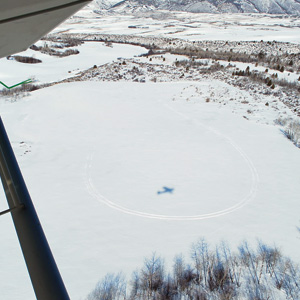
The tracks show the landing and, more important, the turnaround, which is especially tricky on the mountain slopes. Once the turn is started and you’re headed back downhill, you are committed—no brakes!
During another flight I dropped into the rarely visited but nearby controlled, and of course, big paved airport in Pocatello, Idaho. Going to wheel mode I landed, taxied over to the tower, shut down, got out and took a picture. Then I got right back in and after the usual routine at a controlled airport (I have information Alpha, blah, blah) took off, and after the appropriate interval shut the com radio off, turned the Sirius sound system back on, and 15 minutes later and a thousand foot higher landed in a remote canyon in 12-inch spring powder snow. I marveled at the contrast, and the ability to do both (off-airport powder and big-airport asphalt).
Few Regrets
Negatives or other than raves? Let’s see, there’s no getting around the weight increase, but thick winter air sure helps out there. I really miss my 26-inch Airstreaks (Alaskan Bushwheel), when going to the skis, but you can’t have it all, and I get by with the 8.00s. I do have to remind myself not to “boony-bash” like I do in the summer while on the smaller tires. I just go find some snow and use the skis, which of course is the whole point. The current ski/tire combo is more than adequate for any grass strip; I just stay off the truly rough stuff that doesn’t faze me one bit when on the Airstreaks.
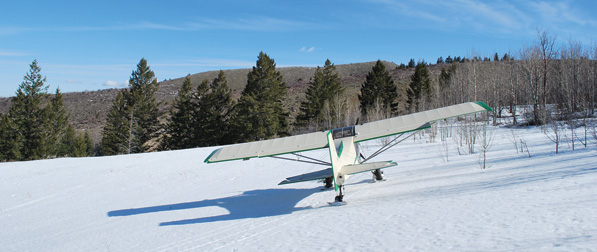
One of the little mountain clearings that make the turnaround the most interesting part. Too slow and you have no rudder response, so it takes a little faith and throttle to goose it to make the turn before the trees.
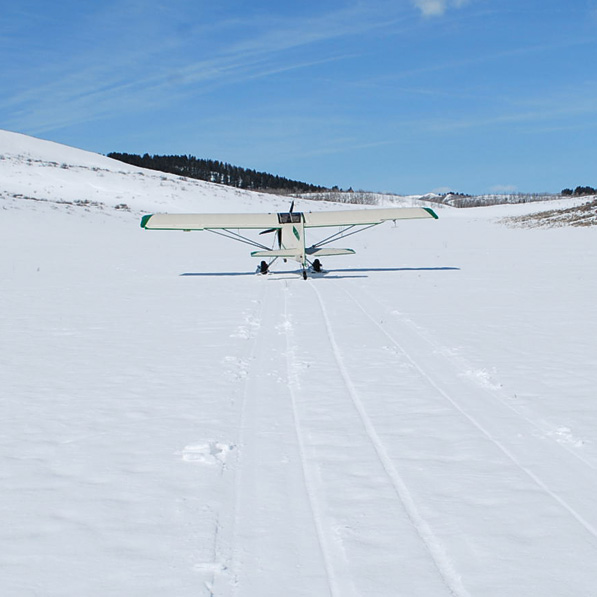
On 18 inches of fresh snow, somewhere above the 8000-foot level a few miles from the author’s home.
How about no brakes! Seriously, I’d be very interested in some kind of skeg that was cockpit controllable and could serve as a crude drag-type brake. But it would weigh more and be in-flight draggy.
I did have to forgo a dual brake system, (dual slave cylinders per wheel) like many who are into big tires and off-airport landings have. The ski structure needs a little room and it would be pretty tight to go with duals, but that’s all right as I saved the weight and extra money.
Speaking of which, these skis are pricey—the main skis themselves are just under $4000 Canadian—but in all fairness the quality is top notch and they are made to last. This factors into the weight issue, as they are quite robust. All told, I am happy with the entire design and materials used.
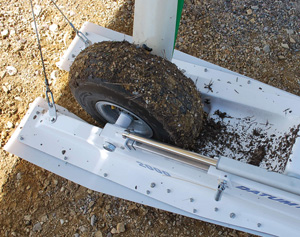
The day this photo was taken, the author realized it might be time to take the skis off and put the Bushwheels back on, as post-flight there was more mud than snow on the wheel/skis. He has about 5000 feet of vertical terrain to play in, so it can be green grass down low, muddy higher up, and snow high up. The wheel feature of these skis makes it all possible.
Perpetual Motion
I got in three weeks of intense ski flying before I started coming home with more mud than snow on the skis, as by then even my runway was thawed out. While there was still plenty of snow at 8000 feet and above, I figured it was time to go back to the Airstreaks. For the first time in 30 years I began looking forward to the winter snows, as they will no longer mean an end to flying off of my mountain airstrip. My flying season is now year-round. While mountain ski flying does introduce some obvious potential new hazards, the ability to land just about anywhere in an emergency more than makes up for them. And the fun factor is off the chart!
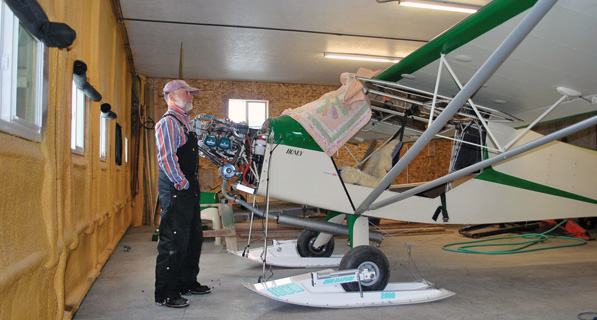
For more ski information, call 819/297-2426 or visit www.datumair.com. For more on RANS, visit www.rans.com.

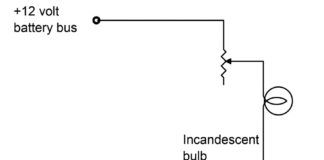
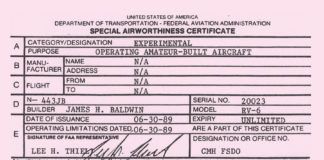
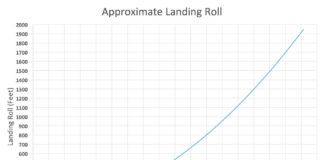
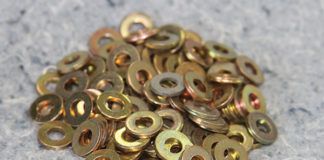
Great article Tom!
Found myself fondly reminiscing of ski flying in our family Taylorcraft BC12D in South Dakota. My Federal Skis and lack of tail ski were much more “barbarian Ops” than you!
Still flying the S7? Would you allow summer visitors? (Maule M5)
Take Care!
RR “Smokey”
Yes, and yes! Tomorrow morning as a matter of fact. Oddly enough, a Maule M5 is the only cert plane to visit my short strip, and he made it look easy, which it is.
Tom: Interesting idea but may be problematic in 4 ft. of powder on the Upper Green, like we had in the last storm. Perhaps wait until the snow “settled and sets up” a bit? Doesn’t look to me like there is enough surface area on those skis to carry the weight and float in true powder.
Sounds like those 26” Airstreaks are the bush tire for the S7S in the backcountry during the summer.
https://www.kitplanes.com/ski-patrol/
Sent from my iPad
Tom Simko, I’ve been watching for you, my old friend, assuming you are the same Tom I went and graduated HighSchool with in 1967 from Allen Park, as the photos surely could be you, but if I’m wrong I apologize. Please contact me as noted below. Don Knowles and Diane Friedly and I have been reminiscing about you!